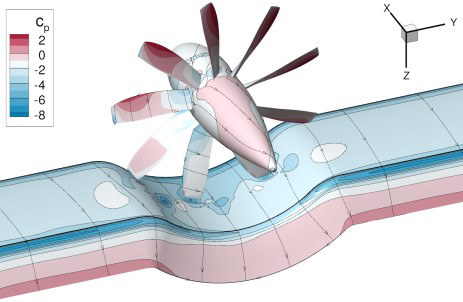

In aviation, a significant reduction of fuel consumption and emission requires new, more revolutionary concepts. A large number of propellers along the wing, called distributed propulsion (DP), is such a concept. Due to the distributed propeller slipstreams, the flow over the wing is enhanced compared to an unblown wing, resulting in a higher lift. Therefore, less wing span and area is necessary during take-off and landing. Thus, the wings can be optimised for cruise flight, giving leverage for less wing drag and weight. So far, electric DP was only investigated for small aircrafts of the general aviation in a low-speed range. Therefore, the next step of research should be the investigation of the feasibility of DP for a short-haul aircraft with 30 – 40 tons MTOW in cruise flight conditions. This is the objective of the project B1.1 „Propeller and wing aerodynamics of distributed propulsion„.
To achieve this, a parametrical study of the DP and wing configuration will be conducted with steady and unsteady simulations. First, an automated process for the fast assessment of a high number of configurations will be developed. The propellers will be modelled with actuator disks and varied regarding their radius, rotational speed, number and positioning relative to the wing. Additionally, high fidelity simulations with full 3D blades will be performed to examine the interactions of propeller and wing as well as between the propellers themselves. Finally, the applicability of DP for commercial short-haul aircrafts will be evaluated for different operating points and the most promising DP configurations will be identified. Consequently, this research project shall provide the aerodynamic basis for the application of DP in commercial short-haul aircrafts.
Prof. Dr.-Ing. Jens Friedrichs
Institute of Jet propulsion and Turbomachinery
+49 531 391 94200